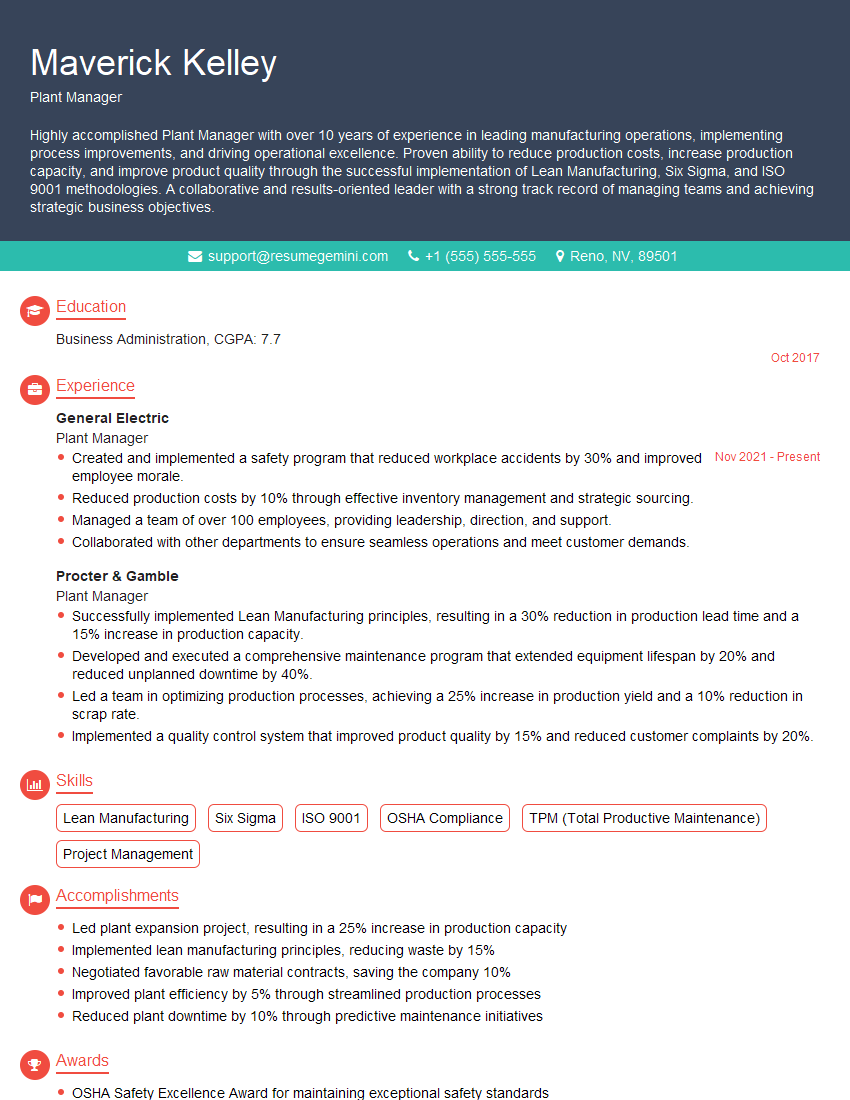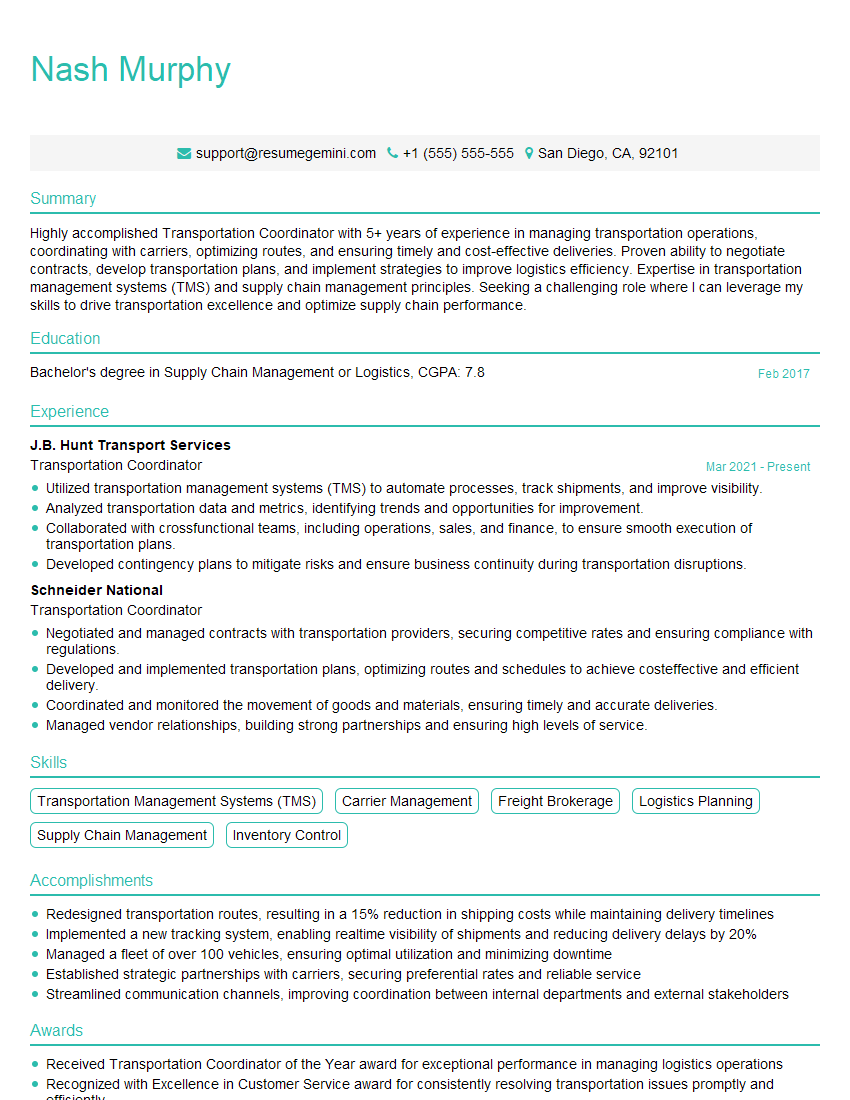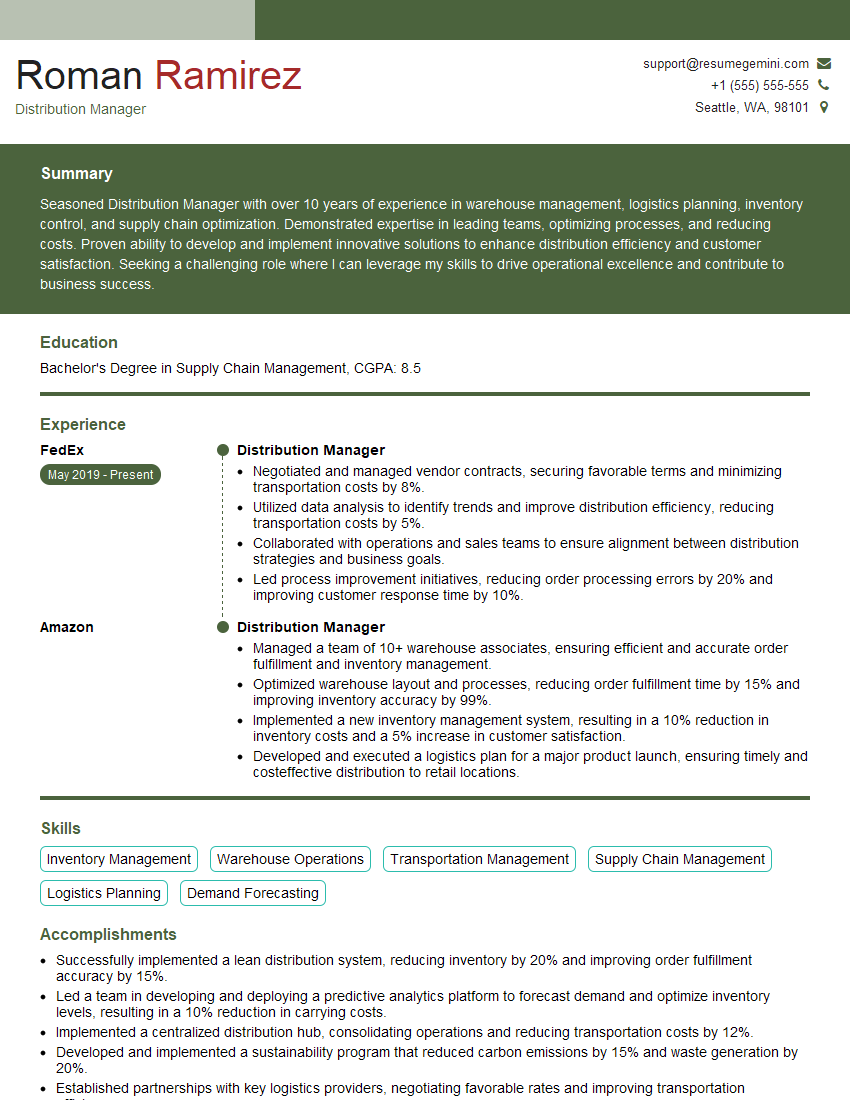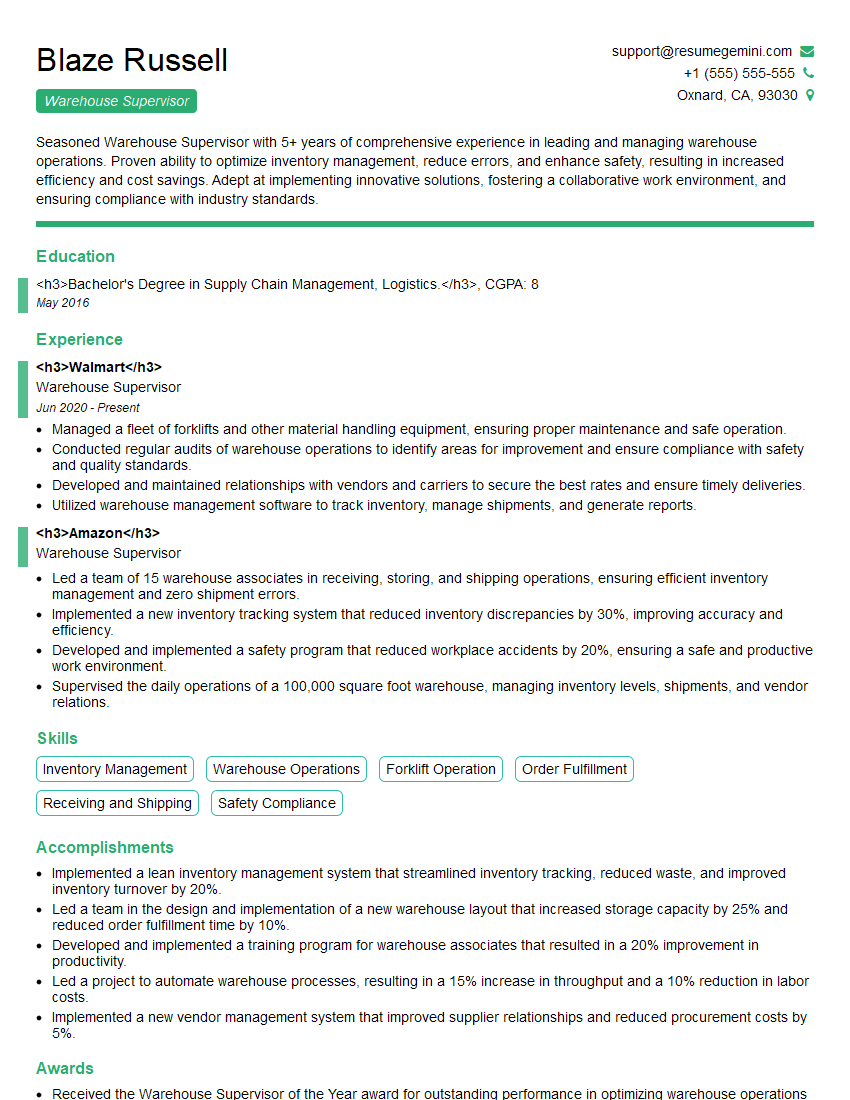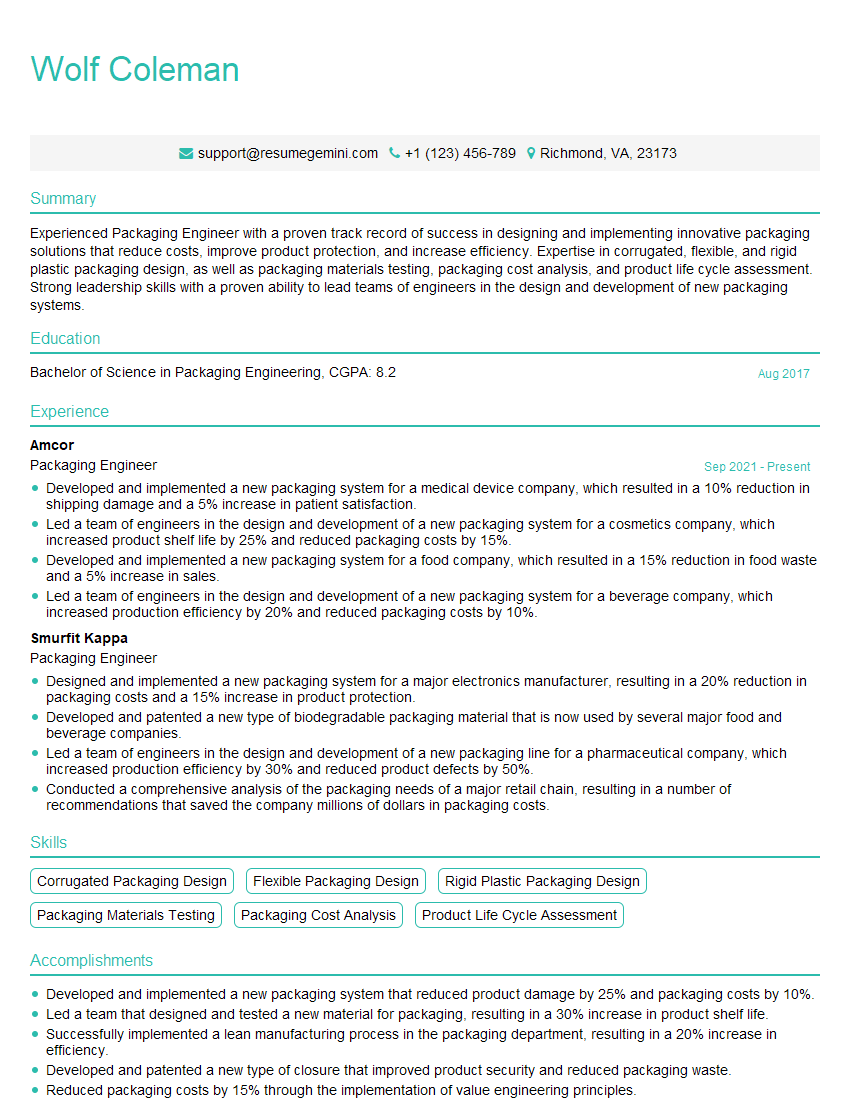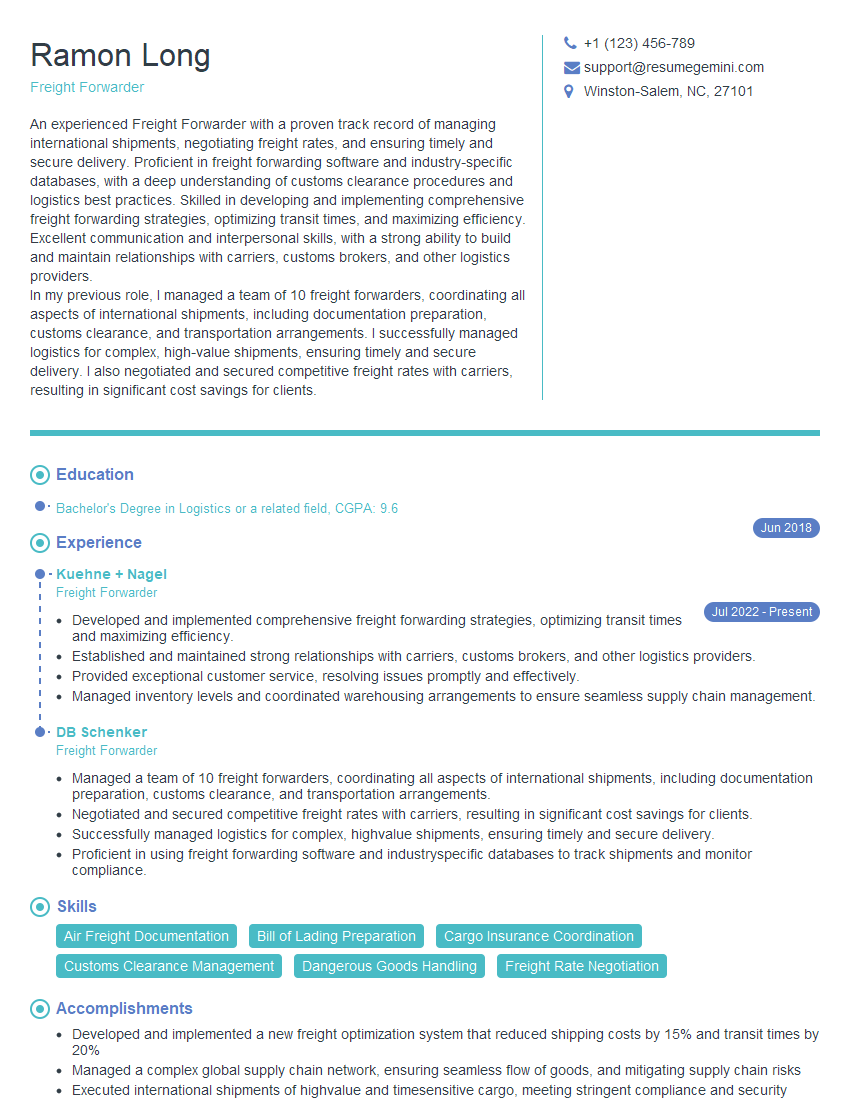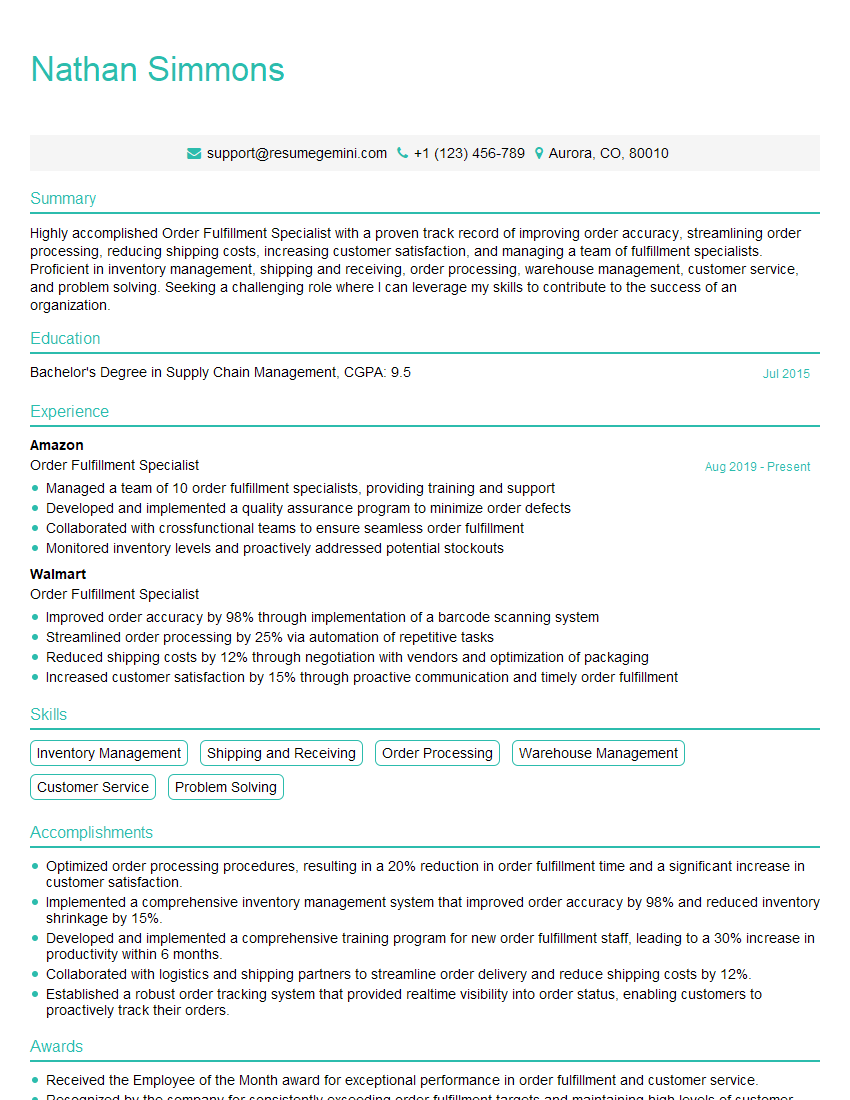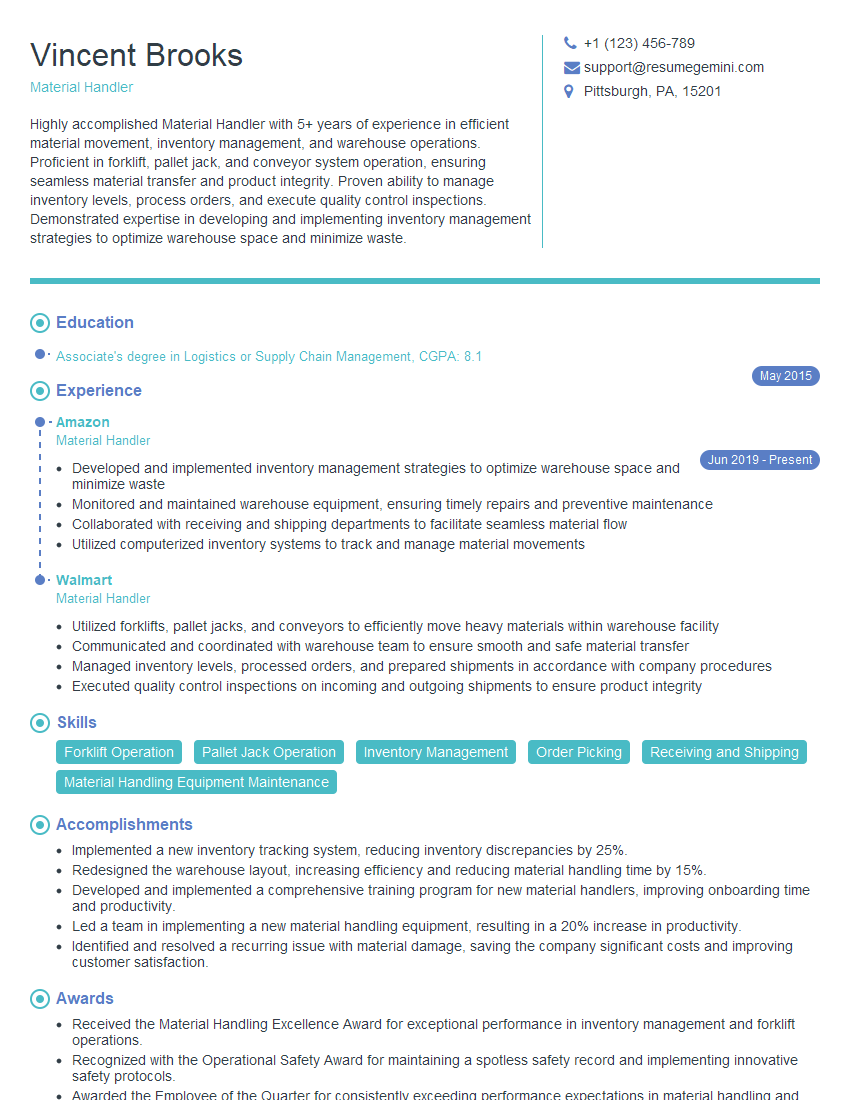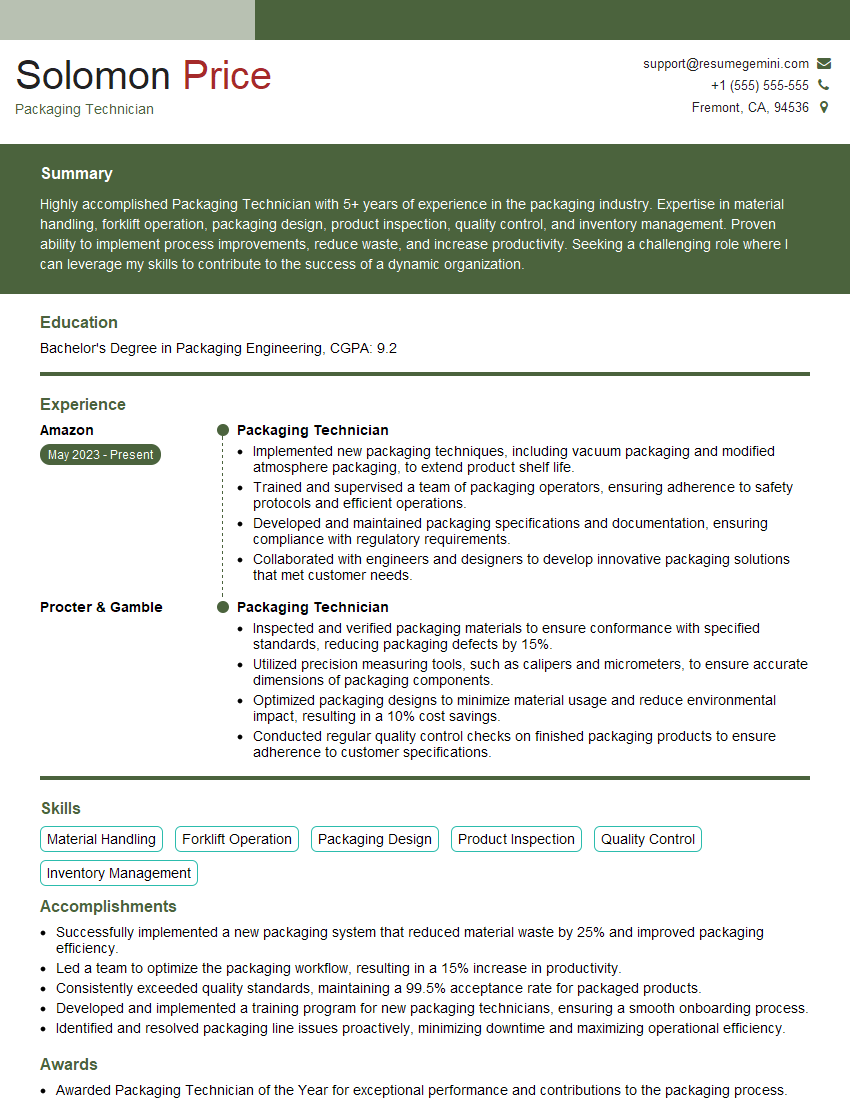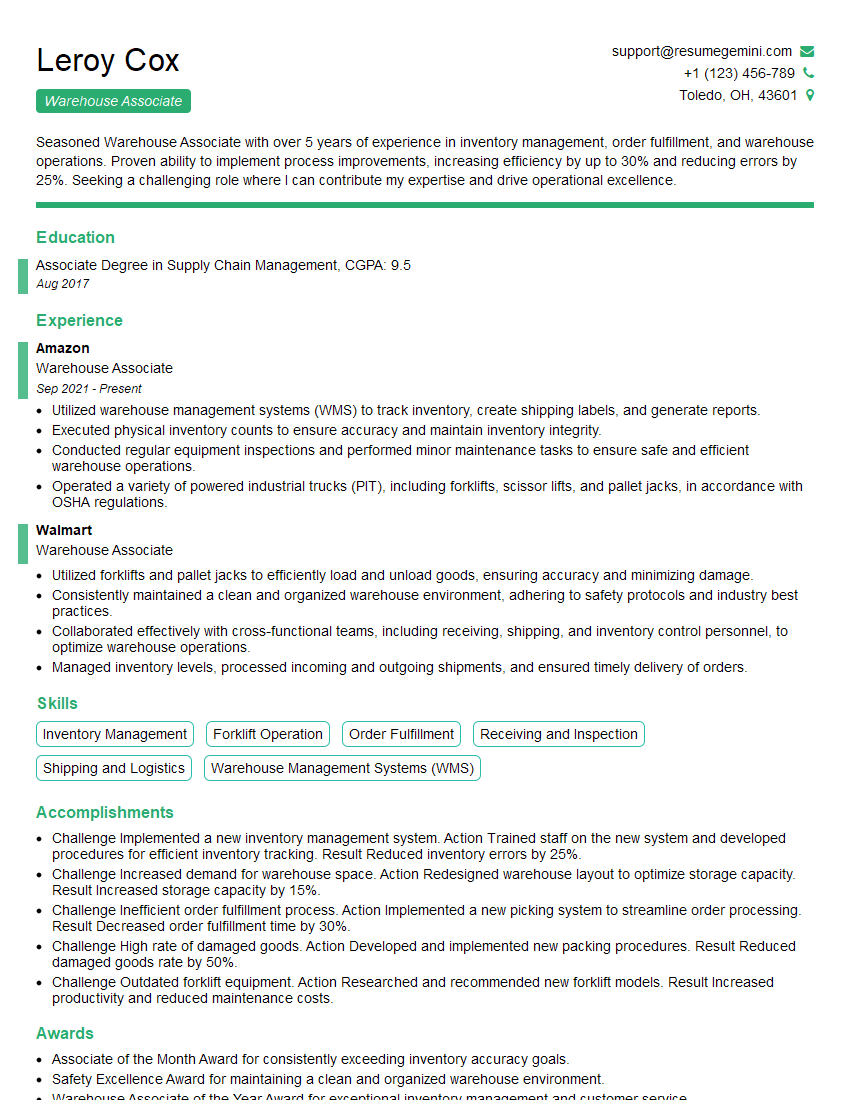Interviews are more than just a Q&A session—they’re a chance to prove your worth. This blog dives into essential Pallet Wrap and Securement interview questions and expert tips to help you align your answers with what hiring managers are looking for. Start preparing to shine!
Questions Asked in Pallet Wrap and Securement Interview
Q 1. What are the different types of pallet wrap available?
Pallet wrap comes in several varieties, each suited for different needs and applications. The most common types include:
- Stretch Film: This is the most widely used type, available in various thicknesses and gauges. Hand-applied or machine-applied, it offers excellent load stability. Think of it like a ‘hug’ for your pallet, holding everything together tightly.
- Cast Stretch Film: Known for its superior strength and puncture resistance compared to blown film. It’s often preferred for heavier or more fragile loads. Imagine it as the ‘bodyguard’ of your pallet, offering extra protection.
- Blown Stretch Film: A more economical option, it’s generally less strong than cast film but still suitable for many applications. It’s like the ‘reliable friend’ of your pallet—good enough for the job, usually at a lower cost.
- Pre-Stretch Film: This film is pre-stretched during the manufacturing process, meaning less film is needed for the same level of containment. This reduces material waste and costs while maintaining excellent load stability. It’s like having a ‘stretchy superhero’ on your team.
- Colored Stretch Film: Available in various colors, this helps with load identification and security. A company might use it to differentiate between different product lines or to signal a special handling requirement (e.g., fragile).
- Pallet Wrapping Paper: A less common alternative to film, mainly used for protection against dust and moisture, and is less effective for load stabilization. This is more like the ‘blanket’ of your pallet for protection against elements.
The choice of wrap depends on factors like load weight, contents, fragility, transportation distance, and budget.
Q 2. Explain the importance of proper pallet wrapping techniques.
Proper pallet wrapping is crucial for several reasons: it ensures load stability during transportation and handling, minimizes product damage, prevents shifting or collapse of the load, reduces the risk of accidents and injuries, and improves overall efficiency. Improper wrapping can lead to significant financial losses due to product damage, delays, and potential safety incidents.
Imagine a stack of neatly arranged glasses. Without proper wrapping, they’re likely to shatter during transport. Proper wrapping acts as insurance, ensuring your goods arrive at their destination safe and sound. Moreover, the secure pallet is easier for forklifts to handle and reduces the chance of accidents.
Q 3. Describe your experience with various pallet wrapping machines.
My experience spans a wide range of pallet wrapping machines, from basic manual turntables to fully automated robotic systems. I’ve worked with:
- Manual Turntables: These are simple, cost-effective machines perfect for low-volume operations. I’ve used them to wrap everything from small boxes to individual components.
- Semi-Automatic Stretch Wrappers: These machines offer a balance between speed and control. The operator loads the pallet, and the machine does the wrapping automatically, giving greater control on wrap tension and rotations.
- Fully Automatic Stretch Wrappers: For high-volume operations, these machines are a necessity, dramatically increasing efficiency. They automatically load, wrap, and unload pallets, requiring minimal human intervention. I’ve overseen the integration of these systems into large-scale distribution centers, significantly improving throughput.
- Robotic Stretch Wrapping Systems: These represent the cutting edge, integrating robotics for highly customized wrapping solutions. This level of automation allows for dynamic wrapping patterns tailored to specific load configurations and fragility needs. I have worked with several implementations that have improved efficiency and minimized product damage by adapting to unevenly shaped and sized loads.
My experience includes troubleshooting, maintenance, and operator training for each of these systems. Understanding the capabilities and limitations of each type of machine allows me to select the optimal solution for any given application.
Q 4. How do you determine the appropriate amount of pallet wrap needed for a load?
Determining the appropriate amount of pallet wrap involves several factors:
- Load weight and dimensions: Heavier and larger loads require more wrap.
- Load stability: Loads with unstable or irregularly shaped contents need more secure wrapping.
- Transportation distance and conditions: Longer distances and rougher handling necessitate more wrap.
- Product fragility: Fragile items require extra protection and consequently, more wrap.
- Wrap type and pre-stretch: Different films have varying strengths and pre-stretch capabilities, influencing the amount needed.
Often, a combination of experience and established company standards plays a role, but the load should never be compromised. There are industry-specific standards and guidelines to help determine the amount of wrap and the technique to ensure safe transportation.
In some cases, software or load-calculating tools are used to optimize the wrapping process.
Q 5. What are the common safety hazards associated with pallet wrapping?
Safety hazards associated with pallet wrapping include:
- Strangulation: Loose wrap can become entangled around limbs, causing serious injury or even death. This is particularly relevant with manual wrapping, where entanglement is more common.
- Crush injuries: Heavy pallets or collapsing loads can crush fingers or other body parts.
- Back injuries: Manual wrapping can involve repetitive lifting and twisting movements, leading to back strain or injury.
- Machine malfunctions: Malfunctioning wrapping machines can cause injuries due to unexpected movements or pinching points. Regular maintenance and operator training are key to avoiding these risks.
- Slips, trips and falls: Wet floors or cluttered work areas pose a tripping hazard, especially when working with pallets.
Strict adherence to safety protocols, regular machine inspections, and appropriate personal protective equipment (PPE), such as gloves and safety shoes, are critical to minimizing these hazards.
Q 6. How do you handle damaged or compromised pallet wrap?
Damaged or compromised pallet wrap should never be used. It compromises the load’s integrity and increases the risk of damage and accidents during transport. Upon discovering damaged wrap, I would:
- Isolate the affected pallet: Prevent accidental use and possible injury.
- Assess the damage: Determine if it’s repairable or requires re-wrapping.
- Re-wrap the pallet: If necessary, use appropriate wrap to ensure adequate protection and load stability. This could involve completely re-wrapping or targeted reinforcement in the damaged area.
- Document the incident: Record the damage, the steps taken, and any potential contributing factors.
- Dispose of damaged wrap properly: Recycle or dispose of the damaged wrap according to environmental regulations.
It’s crucial to prioritize safety and avoid using compromised wrap to prevent potential damage and accidents.
Q 7. What are the different methods for securing pallets during transportation?
Securing pallets during transportation goes beyond just wrapping. Several methods contribute to overall load stability:
- Stretch Wrapping: As discussed, this is the primary method for containing the load.
- Strapping: Steel or plastic straps provide additional reinforcement, particularly for heavier or taller loads. They offer compression and prevent shifting of the individual packages within the pallet.
- Corner Boards: These protect the load’s edges and provide extra stability. It’s like adding extra support to the structure.
- Dunnage: This includes materials like blocks, fillers, and airbags, used to fill voids within the pallet, preventing shifting and improving load stability, particularly effective with oddly-shaped items.
- Load Locks and Securement Systems: For specialized transportation, these systems use bars, beams, and ratcheting mechanisms to fix loads securely in place within the vehicle, often in combination with other methods. These are crucial for preventing movement during transit on trucks and especially during shipping by rail or sea.
The optimal method depends on several factors, including load characteristics, transportation mode, and regulatory requirements. A layered approach often produces the most effective and safest results.
Q 8. Explain the importance of load stability and how it relates to securement.
Load stability is paramount in ensuring safe and efficient transportation. It refers to a load’s ability to remain secure and upright throughout transit, resisting forces like acceleration, deceleration, and cornering. Securement is the process of using various methods and devices to achieve and maintain this stability. Think of it like this: a well-packed suitcase (the load) needs a sturdy strap (securement) to prevent its contents from shifting and spilling during travel. Without proper securement, even a stable load can become unstable due to external forces. A poorly secured load is a significant safety hazard, potentially leading to accidents, cargo damage, and injuries.
Q 9. Describe your experience with load securement devices (e.g., straps, corner boards).
My experience encompasses a wide range of load securement devices. I’ve extensively used cargo straps, both ratchet and cam buckle types, for various load sizes and weights. I’m proficient in selecting the appropriate strap type and tension based on the cargo’s characteristics and the transportation method. Corner boards are another essential tool, particularly effective in protecting palletized goods from shifting or damage during transit. I’ve worked with various materials, from wood to plastic, and understand their strengths and limitations. I’m also familiar with other devices like edge protectors, dunnage bags, and load bars, choosing the most suitable combination depending on the specifics of each job. For example, when securing fragile ceramic goods, I’d prioritize corner boards and stretch wrap for optimal protection, whereas heavier, more robust items might only need straps.
Q 10. How do you ensure compliance with regulations regarding load securement?
Compliance with load securement regulations is non-negotiable. I meticulously follow guidelines set by organizations like the Department of Transportation (DOT) and other relevant bodies. This involves understanding and adhering to weight limits, proper tensioning techniques, and the correct application of securing devices. Regular training and updates on regulations ensure I stay abreast of any changes. Before every load securement operation, I perform a thorough risk assessment, identifying potential hazards and implementing preventative measures. Documentation is crucial; I maintain detailed records of each securement job, including the type of cargo, the securing methods employed, and any observations during the process. This thorough approach allows us to meet all regulatory compliance needs.
Q 11. What are the consequences of improper pallet wrapping and securement?
Improper pallet wrapping and securement has serious consequences. The most obvious is cargo damage: goods can shift, break, or become unusable during transport. This translates into financial losses for businesses, including replacement costs, repair expenses, and potential loss of revenue due to delays or damaged products. Beyond financial impact, improper securement poses significant safety risks. A shifting load can cause accidents, potentially leading to vehicle rollovers, injuries to drivers and others, and even fatalities. Additionally, inadequate securement can result in fines and legal repercussions from regulatory bodies for non-compliance.
Q 12. How do you identify and address potential issues with pallet stability?
Identifying potential pallet stability issues involves a multi-step process. First, I visually inspect the pallet and its contents, checking for any obvious damage or irregularities. I then assess the weight distribution – an unevenly loaded pallet is more prone to instability. I use a load-measuring device to ensure the total weight does not exceed the pallet’s and the vehicle’s capacity. Finally, I consider the type of goods. Fragile items demand more robust securement than durable goods. Any detected issues are addressed immediately using appropriate techniques, such as repositioning items for better weight distribution or adding extra securing devices. For example, if I find a pallet with excessively heavy items concentrated on one side, I’ll redistribute the weight to balance the load or utilize corner boards to prevent shifting.
Q 13. Describe your experience with different types of pallets (e.g., wood, plastic).
My experience includes working with various pallet types. Wooden pallets are common, offering a relatively inexpensive and readily available solution, but they can be susceptible to damage and pest infestation. Plastic pallets are more durable and hygienic, making them ideal for food and pharmaceutical products, but are generally more expensive. I’m also familiar with other materials such as composite wood and metal pallets, each with its own strengths and weaknesses. The selection of a pallet type is influenced by factors like the type of goods being transported, the transportation distance, and the required level of hygiene or durability. For example, I’d typically avoid using wooden pallets for transporting food products due to hygiene concerns, opting instead for plastic or heat-treated wooden alternatives.
Q 14. How do you adapt your pallet wrapping techniques to different types of goods?
Adapting pallet wrapping techniques depends heavily on the goods being transported. Fragile items require extra layers of wrap, potentially combined with corner boards or edge protectors to prevent damage. Heavier items might need more robust wrapping patterns or additional securing devices like straps. For oddly shaped goods, custom wrapping techniques and securement solutions may be necessary to prevent shifting. For example, when securing glass bottles, I would employ multiple layers of stretch wrap and utilize corner boards for added protection. Conversely, a load of uniformly shaped bricks might require less wrapping and could benefit from the use of load bars to restrain them from movement.
Q 15. What are the key considerations when wrapping fragile items?
Wrapping fragile items requires a multi-layered approach focusing on cushioning, securement, and minimizing impact. We start by ensuring adequate cushioning material, like bubble wrap or air pillows, surrounds each fragile item before it’s placed on the pallet. This initial protection is crucial. Next, we strategically position the fragile items on the pallet, avoiding any overhangs and placing heavier items at the bottom. The wrapping itself needs to be more gentle and we might use a softer stretch film to avoid puncturing or damaging the product. We also increase the number of wraps, perhaps adding a second layer of film, and use a lower tension setting to prevent breakage. Consider this example: Imagine shipping a collection of antique glassware. Each piece would be individually wrapped with bubble wrap, placed in a protective box, and then loaded onto the pallet with padding in between. The entire pallet would then receive several layers of stretch wrap with reduced tension.
Finally, we use corner boards for extra protection during transit, as these are vulnerable points for impact damage. We carefully monitor the wrapping process, checking for any tears or gaps in the film. This meticulous approach helps ensure the safe arrival of even the most delicate goods.
Career Expert Tips:
- Ace those interviews! Prepare effectively by reviewing the Top 50 Most Common Interview Questions on ResumeGemini.
- Navigate your job search with confidence! Explore a wide range of Career Tips on ResumeGemini. Learn about common challenges and recommendations to overcome them.
- Craft the perfect resume! Master the Art of Resume Writing with ResumeGemini’s guide. Showcase your unique qualifications and achievements effectively.
- Don’t miss out on holiday savings! Build your dream resume with ResumeGemini’s ATS optimized templates.
Q 16. How do you handle oversized or irregularly shaped loads?
Handling oversized or irregularly shaped loads demands creativity and a thorough understanding of center of gravity. The key is to optimize weight distribution to prevent shifting during transport. We might need to utilize additional securing methods like corner boards, straps, or even custom-built wooden frames to stabilize the load. For example, a long, thin pipe would require strong straps to secure it to the pallet and prevent it from rolling. Irregularly shaped items need careful placement to maintain balance, potentially requiring filling gaps with padding material. We also use load bars or edge protectors to prevent damage to the product and the wrapping material. Before wrapping, we always conduct a visual inspection to assess the load’s stability. Proper documentation of the securement methods is vital for insurance purposes and tracing in case of damage.
Q 17. What is your experience with stretch film dispensing and machine maintenance?
My experience with stretch film dispensing equipment includes both manual and automated systems. I am proficient in operating various models, understanding their functionalities, and troubleshooting common issues. I am familiar with different types of film, including cast and blown film, and their respective properties. Regarding machine maintenance, I have experience with preventative maintenance such as pre-shift checks, lubricating moving parts, and replacing worn components. I can diagnose and resolve issues like film jams, inconsistent film tension, and pre-cut issues. Regular cleaning and ensuring the carriage moves freely are also essential parts of my routine. For instance, I regularly check for film buildup around the rollers, which can cause tearing or jams. In case of a mechanical issue, I can assess the problem, diagnose the root cause, and usually conduct the repair using the appropriate spare parts. For complex situations, I know when to call in a specialized technician.
Q 18. Describe your experience with load planning and optimization.
Load planning and optimization is paramount for efficient and safe transport. My approach begins with analyzing the dimensions and weight of each item, considering its fragility and stability. I then create a plan to optimize pallet space, minimizing voids and maximizing stability. This often involves arranging heavier items lower and at the center of gravity, distributing weight evenly. I utilize software to simulate different loading configurations and assess their stability under various conditions. For example, a pallet with mixed sizes of boxes might benefit from a jigsaw-like arrangement to fill empty spaces, maximizing stability and reducing the chance of shifting during transit. Efficient load planning also minimizes the amount of stretch film needed, reducing material cost and environmental impact. Proper documentation of the loading plan, including item placement and weights, is critical for tracing and insurance.
Q 19. How do you calculate the appropriate tension for pallet wrapping?
Calculating the appropriate tension for pallet wrapping isn’t a fixed formula but depends on several factors: the weight of the load, the type of goods, the film’s strength, and the journey’s duration and potential handling stresses. Too little tension leads to loose wraps and insufficient securement; too much tension can damage goods or cause the film to break. There isn’t a single number, but rather a range that’s determined by experience and observation. For example, a lighter load of books might only require moderate tension, while a pallet of heavy machinery demands substantially more. Modern wrapping machines often have sensors that regulate tension automatically; however, manual adjustments might be needed based on load specifics. We typically start with a moderate tension and visually inspect the wrap after completion. If the wrap appears loose, we add more tension to subsequent layers. It’s a balance between securement and avoiding damage.
Q 20. Explain your understanding of load weight distribution and its impact on securement.
Load weight distribution is critical for pallet stability and securement. An unevenly distributed load is prone to shifting and tipping, especially during transportation. The center of gravity must be low and central for optimal stability. Imagine a pallet with all the weight concentrated on one side—it’s far more likely to tip over than a pallet with the weight evenly spread. We strive to create a stable base by arranging heavier items at the bottom and center, and lighter items on top. This minimizes the risk of shifting during transit. We meticulously document the weight distribution and load details, which helps in preventing issues and assists with any potential insurance claims. Improper weight distribution can cause serious accidents and damage to goods and equipment during handling and transport.
Q 21. How do you handle pallet wrapping in different temperature environments?
Temperature significantly impacts stretch film performance. In extreme cold, the film becomes brittle and prone to cracking, reducing its effectiveness. In extreme heat, it can become sticky and lose its tensile strength. We use appropriate film types designed for specific temperature ranges. For example, we use cold-resistant film in colder climates to maintain its elasticity and prevent cracking. Similarly, in hot environments, we might opt for a film with enhanced heat resistance to avoid excessive stretch and stickiness. Furthermore, the wrapping technique can be adjusted slightly. In extremely cold temperatures, we might increase the number of wraps for enhanced security to compensate for the increased brittleness of the film. In warmer conditions, we must consider that the adhesive properties might change and monitor the wrap to ensure it maintains its secure hold.
Q 22. What are the best practices for documenting pallet wrapping and securement procedures?
Effective documentation of pallet wrapping and securement procedures is crucial for maintaining consistency, ensuring safety, and complying with regulations. Think of it as a recipe for perfect pallet stability – if you don’t write it down clearly, you risk inconsistencies each time someone makes a pallet.
- Standard Operating Procedures (SOPs): Develop detailed, step-by-step instructions covering all aspects, from selecting the right film type and tension to the number of wraps and the final securement method. Include diagrams or photos for clarity.
- Training Materials: Integrate the SOPs into training materials for all personnel involved in the process. This could include videos, checklists, and quizzes to assess understanding.
- Record Keeping: Implement a system for tracking pallet wrapping and securement data. This might include documenting the type of film used, the number of wraps, the date, and the operator’s ID. This is essential for tracing issues if pallets are damaged in transit.
- Regular Audits: Regularly audit the process to ensure compliance with SOPs. Identify areas for improvement and update the documentation accordingly. Use a checklist for efficient auditing.
- Version Control: Use version control for your documentation so everyone is working with the most up-to-date procedures. This prevents confusion and ensures consistency.
For example, an SOP might specify using 20 gauge stretch film with a minimum of three wraps at the base and five wraps around the load, followed by top securement with strapping. Any deviation from this process would need to be documented and justified.
Q 23. What software or systems are you familiar with for managing pallet wrapping and securement?
Several software and systems can be used to manage pallet wrapping and securement processes, ranging from simple spreadsheets to sophisticated Warehouse Management Systems (WMS).
- Spreadsheets (Excel, Google Sheets): While basic, spreadsheets can track key data such as film usage, pallet counts, and any incidents. They’re useful for smaller operations.
- Warehouse Management Systems (WMS): WMS solutions offer comprehensive pallet tracking, inventory management, and often integrate with wrapping equipment to monitor and record wrap parameters (e.g., film type, tension). This provides real-time data and automated reporting capabilities. Examples include SAP EWM, Oracle WMS, and Blue Yonder.
- Transportation Management Systems (TMS): TMSs play a role by providing data on shipments, tracking pallet location and condition throughout the supply chain. This integration improves visibility and accountability.
- Dedicated Pallet Wrapping Software: Some specialized software applications directly control automated wrapping machines, recording settings and generating reports on efficiency and material usage. These often integrate with WMS systems.
Choosing the right system depends on the size and complexity of your operation. For a small business, a simple spreadsheet might suffice, while a large distribution center would need a comprehensive WMS solution.
Q 24. Describe a time you had to troubleshoot a problem related to pallet wrapping or securement.
We once experienced a significant increase in pallet damage during transit. Initial investigations pointed to potential issues with the wrapping process. We systematically investigated several aspects.
- Data Analysis: We reviewed our pallet wrapping data, looking for patterns. We discovered a correlation between higher damage rates and a particular batch of stretch film from a new supplier. This initially suggested an issue with the film’s quality.
- Film Testing: We conducted tests on the film, comparing its tensile strength, elasticity, and puncture resistance to our previous supplier’s film. The tests confirmed the new film was indeed less durable.
- Process Review: We also analyzed our wrapping process. Although we’d maintained the same SOP, there was a slight variation in how some operators were applying the film. We added supplementary visual aids to our training and standardized the wrapping process further.
- Supplier Change: We switched back to our original supplier and implemented stricter quality control checks for all future film purchases.
- Operator Retraining: We retrained operators with an emphasis on the revised SOP and provided them with additional support.
By combining data analysis, thorough testing, and process improvements, we successfully reduced pallet damage rates. This highlighted the importance of vigilant monitoring, detailed record-keeping, and a commitment to continuous improvement in our pallet securement processes.
Q 25. How do you ensure the efficiency of pallet wrapping and securement processes?
Efficiency in pallet wrapping and securement hinges on optimizing several key areas:
- Equipment Selection: Investing in high-quality, automated wrapping equipment can significantly boost speed and reduce labor costs. Consider features such as pre-stretch capability and automatic film cutting.
- Process Optimization: Analyze your current process to identify bottlenecks. This might involve redesigning the pallet layout to improve stability, streamlining workflows, or implementing lean principles to minimize wasted movements.
- Operator Training: Well-trained operators are essential for efficient and consistent wrapping. Regular refresher training ensures best practices are consistently followed.
- Film Selection: Choose the appropriate film type and gauge based on the load’s weight, size, and fragility. Using the wrong film can lead to increased film consumption and higher damage rates.
- Preventive Maintenance: Regular maintenance of wrapping equipment minimizes downtime and ensures consistent performance. A well-maintained machine operates more efficiently.
- Data Monitoring and Analysis: Track key metrics such as wrapping speed, film consumption, and damage rates. Analyze this data to identify areas for improvement and measure the effectiveness of changes.
For example, implementing a system for pre-stretching the film before wrapping can significantly reduce film usage and increase wrapping speed, leading to improved efficiency.
Q 26. What are the industry best practices for sustainable pallet wrapping and securement?
Sustainable pallet wrapping and securement focuses on minimizing environmental impact while maintaining load security. Key practices include:
- Recycled Film: Utilize stretch film made from recycled materials. Many suppliers now offer high-quality recycled content film that performs as well as virgin material.
- Biodegradable/Compostable Film: Explore the use of biodegradable or compostable film alternatives, although the availability and cost-effectiveness of these options vary depending on your location and application.
- Reduced Film Usage: Optimize wrapping techniques to reduce film consumption without compromising load security. This can involve improving operator training, using pre-stretch technology, and optimizing pallet construction.
- Film Recycling Programs: Implement a program for collecting and recycling used stretch film. Partnering with a recycling company can facilitate this process.
- Sustainable Packaging Materials: Consider using eco-friendly alternatives for other pallet components, such as reusable or recyclable pallets and strapping made from recycled materials.
- Improved Pallet Design: Optimize pallet design to improve load stability, reducing the need for excessive wrapping.
For instance, some companies are now using lightweight, yet strong, pallets made from recycled wood or even plastic alternatives, reducing the overall environmental footprint of the packaging.
Q 27. How do you stay up-to-date on the latest trends and technologies in pallet wrapping and securement?
Staying current in this dynamic field requires a multi-faceted approach:
- Industry Publications: Read trade magazines and journals focused on logistics, packaging, and supply chain management. These publications often feature articles on the latest trends and technologies.
- Industry Events and Conferences: Attend industry events, conferences, and trade shows to learn from experts and network with peers. This provides firsthand exposure to new innovations.
- Online Resources: Regularly check websites and online forums dedicated to packaging and supply chain topics. These often provide updates on new products and technologies.
- Supplier Relationships: Maintain strong relationships with your packaging suppliers. They are often at the forefront of innovation and can share insights into new developments.
- Professional Organizations: Join professional organizations related to logistics, packaging, or supply chain management. Many offer educational resources, training, and networking opportunities.
- Continuous Learning: Actively seek out training and educational opportunities to improve your knowledge and skills. This could include online courses, workshops, or certifications.
For example, I regularly attend the PACK EXPO trade show to see the latest innovations in packaging technology and connect with leading suppliers of pallet wrapping and securement solutions.
Key Topics to Learn for Pallet Wrap and Securement Interview
- Types of Pallet Wrap: Understanding the differences between stretch wrap, shrink wrap, and other specialized films, including their strengths and weaknesses for various applications.
- Pallet Wrapping Techniques: Mastering both manual and automated wrapping techniques, including considerations for optimal tension, overlap, and pre-stretch.
- Securement Methods: Exploring various securement methods beyond wrapping, such as strapping, corner boards, and dunnage, and understanding their application based on load characteristics.
- Load Stability and Center of Gravity: Analyzing how load weight distribution and center of gravity impact the effectiveness of wrapping and securement strategies.
- Regulations and Safety Standards: Familiarity with relevant industry regulations and safety standards related to load securement and transportation.
- Damage Prevention and Loss Reduction: Understanding how proper wrapping and securement prevent product damage during transit and storage, minimizing losses for businesses.
- Equipment and Machinery: Knowledge of different types of pallet wrapping machines, their operation, and maintenance.
- Cost Optimization: Analyzing different wrapping and securement methods to determine the most cost-effective solutions while maintaining safety and integrity.
- Problem-Solving in Pallet Securement: Developing a systematic approach to identifying and solving potential issues related to load stability and securement during transportation and handling.
- Sustainable Practices: Understanding environmentally friendly wrapping materials and techniques, and their impact on the supply chain.
Next Steps
Mastering pallet wrap and securement techniques is crucial for career advancement in logistics, warehousing, and supply chain management. These skills demonstrate a commitment to efficiency, safety, and loss prevention—highly valued attributes in today’s competitive job market. To significantly improve your job prospects, it’s essential to create a compelling, ATS-friendly resume that highlights your expertise. ResumeGemini is a trusted resource that can help you craft a professional and effective resume. They provide examples of resumes specifically tailored to highlight experience in pallet wrap and securement, helping you stand out from the competition.
Explore more articles
Users Rating of Our Blogs
Share Your Experience
We value your feedback! Please rate our content and share your thoughts (optional).
What Readers Say About Our Blog
Hello,
We found issues with your domain’s email setup that may be sending your messages to spam or blocking them completely. InboxShield Mini shows you how to fix it in minutes — no tech skills required.
Scan your domain now for details: https://inboxshield-mini.com/
— Adam @ InboxShield Mini
Reply STOP to unsubscribe
Hi, are you owner of interviewgemini.com? What if I told you I could help you find extra time in your schedule, reconnect with leads you didn’t even realize you missed, and bring in more “I want to work with you” conversations, without increasing your ad spend or hiring a full-time employee?
All with a flexible, budget-friendly service that could easily pay for itself. Sounds good?
Would it be nice to jump on a quick 10-minute call so I can show you exactly how we make this work?
Best,
Hapei
Marketing Director
Hey, I know you’re the owner of interviewgemini.com. I’ll be quick.
Fundraising for your business is tough and time-consuming. We make it easier by guaranteeing two private investor meetings each month, for six months. No demos, no pitch events – just direct introductions to active investors matched to your startup.
If youR17;re raising, this could help you build real momentum. Want me to send more info?
Hi, I represent an SEO company that specialises in getting you AI citations and higher rankings on Google. I’d like to offer you a 100% free SEO audit for your website. Would you be interested?
Hi, I represent an SEO company that specialises in getting you AI citations and higher rankings on Google. I’d like to offer you a 100% free SEO audit for your website. Would you be interested?
good


